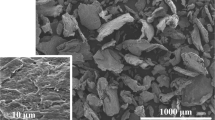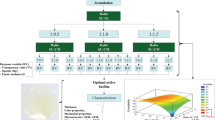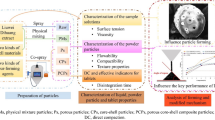An experimental technique was developed for the production of tableted nanostructured fibrous enterosorbent for medical applications using a nanostructured activated carbon fiber material of solid-phase pyrolytic origin, created by our research team. The properties of the main active ingredient in the pills, as an effective adsorbing component, were studied. The porous structure parameters were examined with the desiccator method based on the absorption of benzene vapors, while the specific surface area was analyzed with the Brunauer–Emmett–Teller (BET) method. Spectrophotometric methods were employed to determine the concentration of the sorbate in solutions. The microstructure of the samples was studied using a scanning electron microscope (Superprobe-733 X-ray microanalyzer, JEOL, Japan). Energy-dispersive X-ray analysis provided data on the chemical composition and biocompatibility of the samples, serving as an integral indicator. Conditions for the key stages in the enterosorbent production process were experimentally tested. The influence of different types of binders on the process properties of the tablet charge and on the characteristics of test enterosorbent pills was analyzed. The novelty of the developed process was the use of material with special characteristics, promoted by bound carbon nanoforms present in its structure, for enterosorbent production. Improvements in the process operations were proposed, such as decreasing the compaction speed and simultaneously increasing the time the tablet charge was kept under pressure, leading to the redistribution of strains. It was proposed that the compaction process be conducted using punches with a flat surface of purity class 10 to prevent sticking. Therefore, our research team developed tableted enterosorbent with typical features of its main component—nanostructured activated fibrous carbon material—as an effective adsorbent for a relatively wide range of different compounds.


Similar content being viewed by others
References
Yu.A. Tarasenko, I.I. Gerashchenko, and N.T. Kartel, “Enterosorption as a method for removing heavy metals and radionuclides from the human body,” Poverkhnya, No. 6(21), 110–121 (2014).
I.A. Bobrova, “Enterosorbents yesterday and today: application aspects,” Nov. Med. Farmats., No. 3(532), 8–11 (2015).
V.V. Strelko, V.O. Zazhigalov, and S.S. Stavitska, Selective Sorption and Catalysis on Active Carbon and Inorganic Ion Exchangers [in Ukrainian], Naukova Dumka, Kyiv (2008), p. 303, https://nvdnanu.org.ua/be6482c9-9b33-78bc-cc5e-ff06df994f38.
D. Savchenko and I. Chekman, “Comparative adsorption properties of carbon sorbents,” Ukr. Nauk. Med. Molod. Zh., 1, No. 1, 10–14 (2010).
J. Jandosov, M. Alavijeh, S. Sultakhan, A. Baimenov, M. Bernardo, Z. Sakipova, S. Azat, S. Lyubchyk, N. Zhylybayeva, and G. Naurzbayeva, Activated Carbon/Pectin Composite Enterosorbent for Human Protection from Intoxication with Xenobiotics Pb(II) and Sodium Diclofenac, published online 2022, doi: https://doi.org/10.3390/molecules27072296.
Direct Compressed Activated Carbon Tablet Formulation, Patent WO 2021/134482 A1 France, International Publication Date July 8 (2021), p. 3.
Z. Mansurov, I. Savickaya, A. Kistaubayeva, M. Biysenbayev, S. Tuleybayeva, and A. Nikolayeva, Method for Production of “Ingo-2” Carbon Enterosorbent, Patent EP2694202B1 Germany/France, Publication May 6 (2015), p. 3.
Yu.M. Krasnopolsky and D.M. Pylypenko, Pharmaceutical Biotechnology: Biotechnologies in Production of Finished Dosage Forms [in Ukrainian], Madrid Printing House, Kharkiv (2020), p. 279.
O.V. Shcherbytska, V.V. Garbuz, V.D. Klipov, V.P. Sergeev, I.V. Kononko, V.M. Klevtsov, T.F. Lobunets, and I.V. Uvarova, “Studying the formation of carbon nanostructures in thermal destruction and carbonization of hydrated cellulose fibers,” Nanostrukt. Materialoved., No. 2, 24–31 (2010).
V.M. Gun’ko, V.V. Turov, R. Leboda, V.I. Zarko, J. Skubiszewska-Zieba, and B. Charmas, “Adsorption, NMR and thermally stimulated depolarization current methods for comparative analysis of heterogeneous solid and soft materials,” Langmuir, 23, 3184–3192 (2007).
I.I. Gerashchenko and V.A. Lutsenko, “Quality control of medical sorbents,” Farmatsevt. Zh., No. 5, 37–41 (2010).
V.P. Sergeev, I.V. Kononko, and V.D. Klipov, “Prospects of using novel carbon nanostructured material in medicine,” in: Proc. 11th Int. Sci. Pract. Conf. Innovations and Prospects of World Science, Perfect Publishing, Vancouver, Canada (2022), pp. 144–148.
O.V. Shcherbytska, I.V. Kononko, V.D. Klipov, V.P. Sergeev, and I.V. Uvarova, “Combined medical carbon sorbent,” Visn. Ukr. Materialoznav. Tov., No. 1(11), 15–22 (2018).
I.V. Kononko, N.V. Boshytska, V.P. Sergeev, V.D. Klipov, and N.V. Kononko, “Nanostructured carbon material for reusable protective masks,” Dop. Nats. Akad. Nauk Ukrainy, No. 6, 78–86 (2021).
L.A. Sakhno, V.V. Sarnatska, V.N. Maslenny, L.A. Yushko, L.N. Korneeva, V.G Korotich, and V.G. Nikolaev, “Comparative assessment of various enterosorbents to bind bacterial endotoxins,” Dop. Nats. Akad. Nauk Ukrainy, No. 2, 168–172 (2009), http://dspace.nbuv.gov.ua/handle/123456789/7925/28Sakhno.
Author information
Authors and Affiliations
Corresponding author
Additional information
Translated from Poroshkova Metallurgiya, Vol. 62, Nos. 5–6 (551), pp. 37–48, 2023
Rights and permissions
Springer Nature or its licensor (e.g. a society or other partner) holds exclusive rights to this article under a publishing agreement with the author(s) or other rightsholder(s); author self-archiving of the accepted manuscript version of this article is solely governed by the terms of such publishing agreement and applicable law.
About this article
Cite this article
Serhieiev, V.P., Kononko, I.V., Boshytska, N.V. et al. Properties of Nanostructured Carbon Fiber Material and Process Features of Its Use in Producing Tableted Enterosorbent for Medical Applications. Powder Metall Met Ceram 62, 293–301 (2023). https://doi.org/10.1007/s11106-023-00393-2
Received:
Published:
Issue Date:
DOI: https://doi.org/10.1007/s11106-023-00393-2




